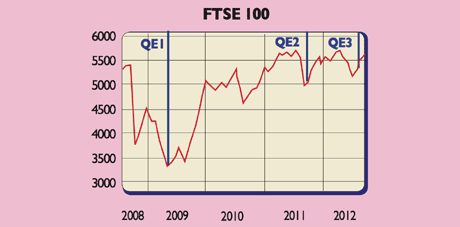
Central banks’ actions show that the global economy is looking ever more sickly, says The Guardian. Last Thursday alone the European Central Bank cut interest rates by a quarter of one per cent to 0.75%, the lowest rate in the 14 years since its inception.
The Bank of China cut rates for the second time in a month. The Bank of England launched a third round of quantitative easing (QE3), or money printing. It is to buy another £50bn of UK government bonds with electronically created money. It will soon have injected a total of £375bn into the economy in this way. America may also soon launch QE3.
America is a mess
Most of Europe is “sinking ever deeper into recession and threatening to drag many of the developing countries that depend on it for their exports with it”, says Alan Abelson in Barron’s. But if the eurozone did not exist, the world would be focused on America, says the FT. The US is suffering from the weakest growth and employment for this stage of a recovery since World War II. Payroll growth has slowed sharply in recent months and unemployment is still over 8%.
Manufacturing is shrinking and service sector activity is at a two-and-a-half-year low. Consumption is lacklustre. The economy faces automatic spending cuts and tax hikes worth a massive 5% of GDP on 1 January if Congress doesn’t agree to postpone or change them – hardly a safe bet in an election year.
“Corporations are starting to pull back in the face of a eurozone recession and policy uncertainty in the US,” says Bank of America Merrill Lynch. That, along with the global slowdown, is denting profit prospects. Earnings estimates look set to be trimmed further, and not only in America.
Central banks to the rescue?
The British economy has “stubbornly refused to expand for the past year and a half” despite the printed money thrown at it so far, says Sam Fleming in The Times. “It is not entirely clear why.”
The Bank of England thinks yet another dose will do the trick. “In terms of feeding through to businesses and consumers”, there has been scant sign of improvement, says Fxpro.com. The key problem with QE on bothsides of the Atlantic is not the availability of money, but a lack of demand. After a financial crisis, consumers spend years more concerned with working off their debt. Companies that aren’t doing the same tend to be reluctant to put cash to work given the subdued environment.
In these circumstances, trying to boost the economy through money printing is akin to “pushing on a string”. In America the impending “fiscal cliff” is going to make post-bubble corporate America even more cautious about hiring and expanding, says Stephanie Pomboy of MacroMavens.
Are markets waking up?
Markets have responded positively to central banks’ liquidity injections since the crisis. However, diminishing returns have set in, as the chart above, highlighted by Fidelity’s Tom Stevenson, illustrates.
Markets were initially buoyed by hopes that QE can boost growth, while some of the money inevitably leaked into asset markets, providing a further fillip. But more and more investors may be starting to acknowledge that QE does little for growth.
The fact that central banks are having to resort to a shot of free money reflects a dismal fundamental environment – even if it does mean liquidity leaks into equity markets. Don’t mistake any rise in equities over the next few months for the beginning of a sustainable bull run.